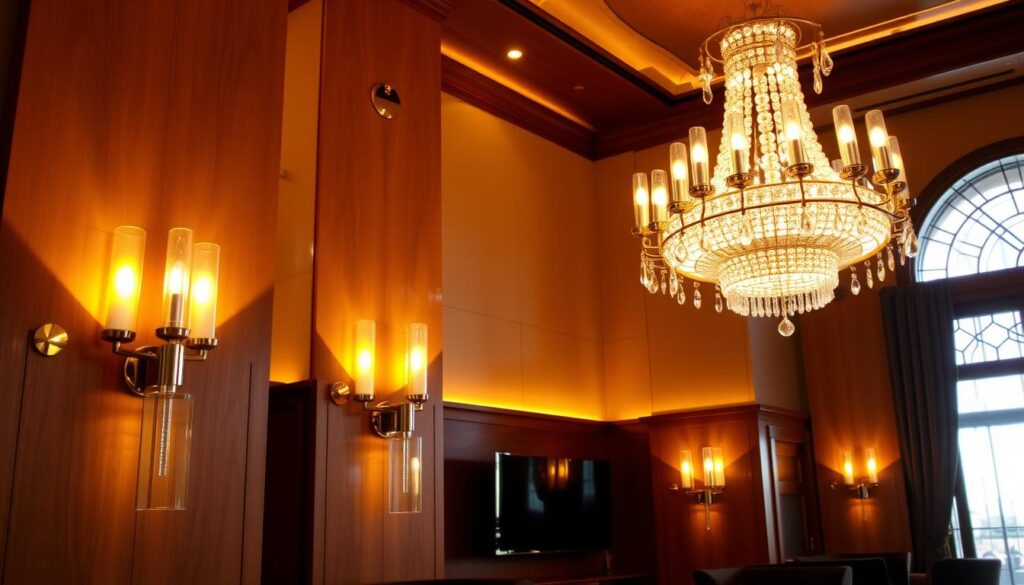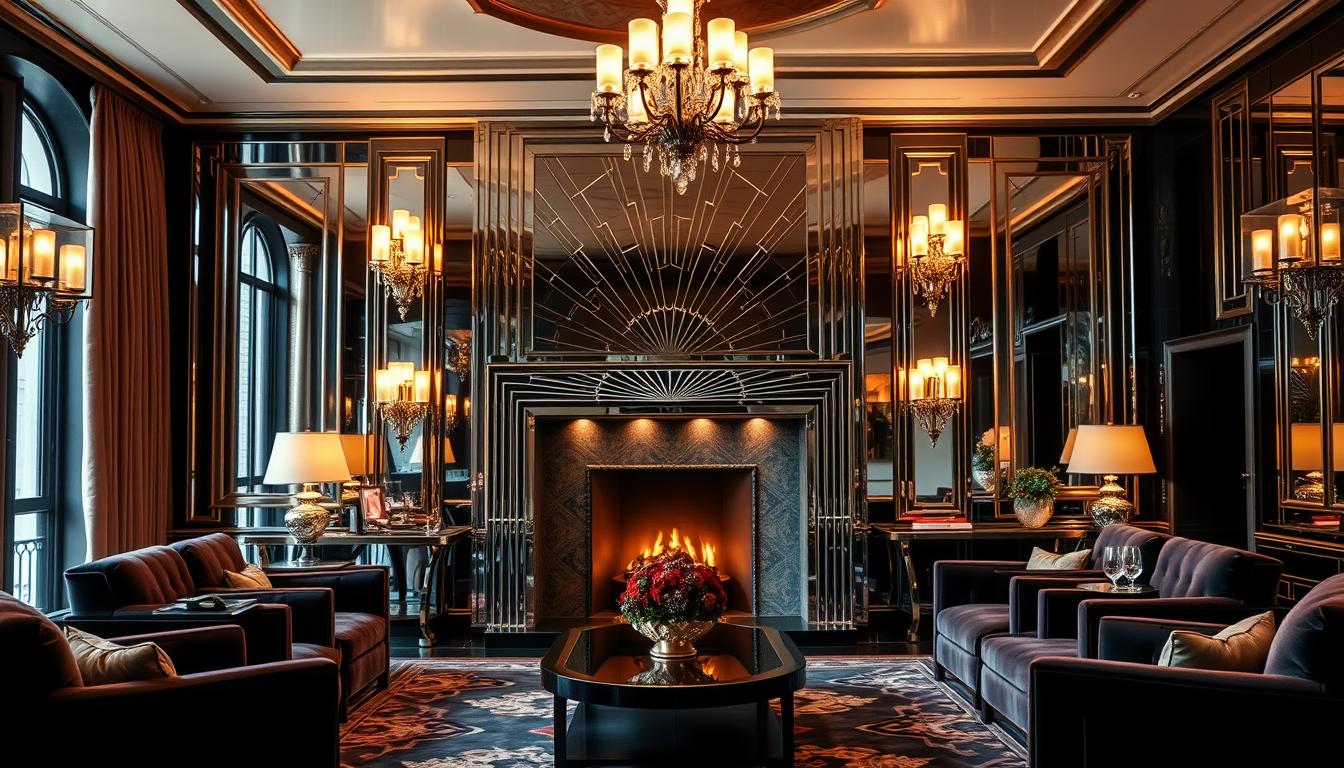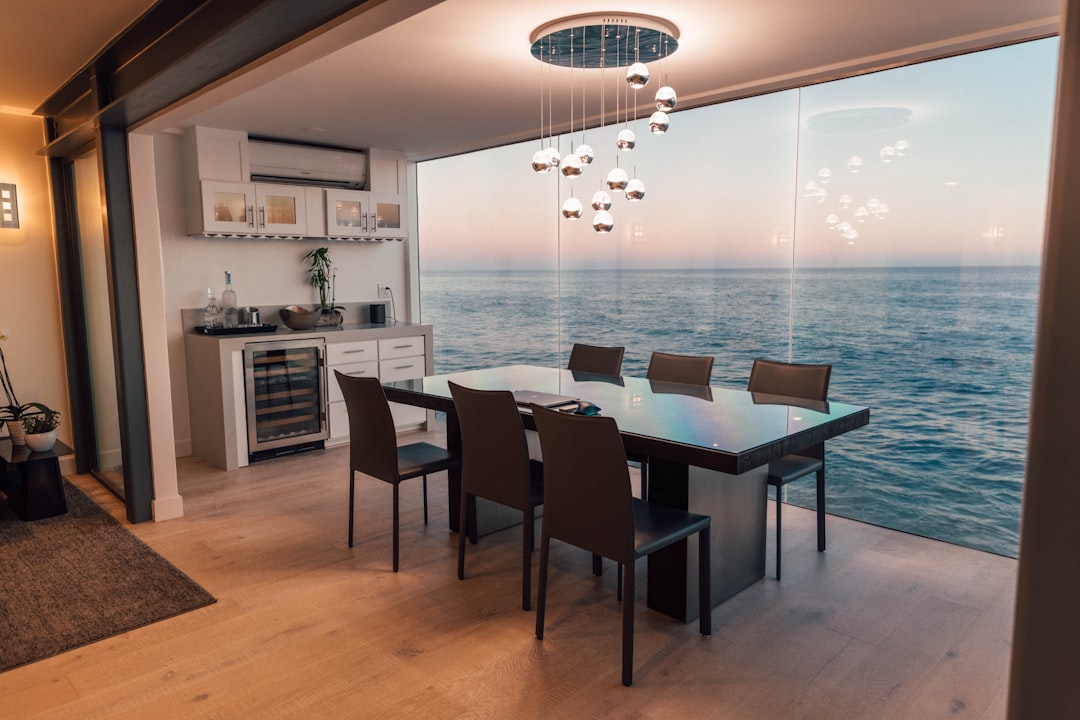Did you know that Art Deco, born in the 1920s, still shapes today’s home decor? This style is known for its bold shapes, rich materials, and a touch of the past. It brings timeless elegance to any room.
Exploring Art Deco interior design reveals its lasting appeal. It’s a mix of glamour and sophistication. Adding this style to your home can be a fulfilling journey.
Key Takeaways
- Understanding the historical context of Art Deco
- Identifying key elements of Art Deco decor
- Learning how to incorporate Art Deco into your home
- Discovering the versatility of Art Deco style
- Exploring the luxurious materials used in Art Deco design
Introduction to Art Deco Style Interior Design
Stepping into the world of Art Deco interior design, we feel luxury and glamour. This style, born in the 1920s and blooming until the 1940s, uses geometric shapes, metallics, and bold colors. It celebrates modernity and opulence.
Art Deco is more than a design; it’s an experience of sophistication and elegance. It’s about making a statement through design, blending modern and nostalgic elements.
Defining Art Deco: A Brief Overview
Art Deco is a design movement known for geometric patterns, luxurious materials, and bold colors. It’s a mix of modern and nostalgic, inspired by ancient cultures and futuristic dreams. To see how we use Art Deco in our designs, visit our page on how we design interior spaces with Art Deco flair.
Key Characteristics of Art Deco
The essence of Art Deco lies in geometric shapes, metallic materials, and bold colors. These elements are used in creative ways to make spaces glamorous and modern. Key features of Art Deco interior design include:
- Statement lighting fixtures that add glamour
- Ornate furnishings that show off craftsmanship
- Decorative accessories that bring color and texture
By using these elements, we can create a space that feels luxurious and sophisticated, just like the Art Deco era.
Historical Context of Art Deco
The Art Deco style started in the 1920s. It has a rich history that shaped its luxurious and modern look. Knowing this history helps us appreciate Art Deco’s depth and complexity.
Origins and Influences
Art Deco comes from many places. It was inspired by the discovery of King Tut’s tomb in 1922. This event made people all over the world interested in ancient Egyptian culture.
It also took elements from Mesopotamia, Africa, and Asia. This shows the era’s love for the exotic. The style mixed old and new, creating its unique look.
Major Developments in the Art Deco Movement
Art Deco changed a lot over time. It started using new materials like chrome and aluminum. This allowed for more creativity in design.
| Development | Description | Impact on Art Deco |
|---|---|---|
| New Materials | Incorporation of chrome, aluminum, and other modern materials | Allowed for greater experimentation with form and texture, enhancing the modernity of Art Deco |
| Technological Advancements | Advances in manufacturing and production techniques | Enabled mass production of Art Deco designs, making the style more accessible |
| Cultural Exchange | Influence of various cultures on Art Deco design | Contributed to the style’s eclecticism and richness, incorporating diverse motifs and patterns |
These changes helped Art Deco grow into a sophisticated and glamorous style. It still influences design and architecture today.
Elements of Art Deco Design
Art Deco is all about glamour and modernity. By adding these elements to our homes, we can make a space that’s both classy and up-to-date.
Geometric Patterns and Shapes
Geometric shapes like chevrons, hexagons, and triangles are key in Art Deco. They add interest to walls, floors, and furniture. You can use them in inlays, tile work, or even wallpaper.
A chevron rug can make a room pop, while hexagonal tiles can wow in a kitchen. These shapes bring depth and beauty to our spaces.
Luxurious Materials and Textures
Art Deco loves luxurious materials and textures. Think velvet, marble, and chrome. They add glamour to any room.
“The use of luxurious materials is what sets Art Deco apart from other design styles. It’s about creating a sense of luxury and sophistication.”
| Material | Common Uses | Aesthetic Impact |
|---|---|---|
| Velvet | Upholstery, Curtains | Luxurious, Soft |
| Marble | Countertops, Flooring | Elegant, Sophisticated |
| Chrome | Lighting, Hardware | Modern, Glamorous |
Bold Colors and Contrasts
Bold colors and contrasts are Art Deco’s hallmark. Mixing rich colors with metallics creates a stunning look. The art deco color palette often features deep jewel tones and metallics.
- Deep jewel tones for a rich, luxurious feel
- Metallic accents for added glamour
- Contrasting colors to create visual interest
By using these elements, we can make a modern art deco space that’s both elegant and sophisticated. Art Deco design offers many ways to enhance our homes, from geometric patterns to luxurious materials and bold colors.
Furniture in Art Deco Interior Design
The furniture in Art Deco interior design is known for its luxury, elegance, and geometric shapes. It’s not just about looks; it’s about making our homes feel luxurious and welcoming.
Iconic Furniture Pieces and Brands
Art Deco furniture is famous for its unique mix of modern and luxurious designs. Designers like Émile-Jacques Ruhlmann and Jean-Michel Frank led the way. Their work used exotic materials, detailed patterns, and a touch of glamour.
Some standout pieces include the Macassar Ebony Buffet by Ruhlmann and Frank’s leather-clad furniture. These items showed off the era’s opulence and raised the bar for luxury design.
How to Incorporate Art Deco Furniture
Adding Art Deco furniture to your home can bring elegance and sophistication. Look for pieces with geometric patterns, luxurious materials, and bold designs. A vintage sofa or a geometric-patterned armchair can be great starting points.
Mixing Art Deco with other styles requires balance. Pairing an Art Deco piece with minimalist or contemporary furniture can create a striking contrast. Make sure the Art Deco piece is the room’s centerpiece.
By carefully choosing Art Deco furniture, we can add timeless elegance and glamour to our homes. This makes our living spaces truly unique and special.
Art Deco Color Palettes
Art Deco is known for its vibrant colors, including rich jewel tones and metallic accents. These colors create bold contrasts and a luxurious feel. They add glamour and sophistication to any space.
Popular Color Combinations
Iconic Art Deco color combos often mix deep blues and greens with metallic gold or silver. This mix creates a dramatic, opulent look. Bold contrasts are key in Art Deco, making colors like emerald green against creamy whites or soft grays stand out.
Using rich jewel tones like rubies, emeralds, and sapphires adds depth. These colors work well for accent pieces, furniture, or even as a bold wall color. They create a focal point in the room.
Creating Balance in Your Color Scheme
Art Deco is bold, but balance is key to avoid overwhelming the senses. Start with a dominant color and add one or two accent colors for contrast. For instance, a room with neutral tones can be enhanced by bold, colorful pieces.
The 60-30-10 rule is helpful: 60% of the room should be a dominant color, 30% a secondary color, and 10% an accent color. This rule ensures a harmonious, visually appealing color scheme that captures the essence of modern Art Deco.
- Start with a neutral base
- Add a secondary color for depth
- Use an accent color to create a focal point
Lighting in Art Deco Interiors
Lighting in Art Deco interiors is more than just functional. It’s a decorative statement that shows off the era’s luxury. Art Deco lighting is bold, eye-catching, and luxurious. It often has geometric shapes, metallic materials, and detailed designs that remind us of the 1920s.
Signature Lighting Fixtures
Art Deco lighting stands out with statement pieces like chandeliers, sconces, and table lamps. These fixtures use materials like chrome, glass, and crystal, which were popular back then. For example, a chrome chandelier with geometric patterns can make a dining room look sophisticated and elegant.
“Lighting is a crucial element that can make or break the ambiance of a room,” say interior design experts. The right Art Deco lighting can make a space feel more luxurious and welcoming.

Tips for Layered Lighting
To create a cozy atmosphere in an Art Deco-inspired home, use layered lighting. This means combining overhead lighting, table lamps, and floor lamps for a balanced look.
- Start with a statement overhead fixture, like a chandelier, to set the tone for the room.
- Add table lamps or sconces with geometric shapes and metallic finishes to complement the overhead lighting.
- Use floor lamps to add depth and create pools of warm light in corners or beside seating areas.
Layering our lighting makes our Art Deco decor visually interesting and dynamic. When designing our lighting scheme, we should think about the overall look we want. Choose fixtures that light up the room well and also match the room’s style and ambiance.
Accessories and Decor in Art Deco Style
To truly embody the spirit of Art Deco, we must consider the accessories and decorative elements. These add a touch of sophistication to our interiors. They are the finishing touches in an Art Deco-inspired space, elevating the overall aesthetic and creating a cohesive look.
Art Deco Artwork and Sculptures
Art Deco artwork and sculptures are integral to capturing the essence of this style. We can incorporate vintage pieces or modern interpretations that reflect the geometric patterns and luxurious feel of Art Deco. Some popular choices include:
- Sculptures with metallic finishes like chrome or bronze
- Artwork featuring bold geometric patterns
- Prints or paintings that reflect the opulence of the Roaring Twenties
When selecting artwork and sculptures, we should consider how they complement the overall vintage interior design theme. By choosing pieces that resonate with the Art Deco era, we can create a harmonious and stylish space.
Textiles and Soft Furnishings
Textiles and soft furnishings play a crucial role in Art Deco interior design. They add warmth, texture, and visual interest to a room. We can incorporate luxurious fabrics such as velvet, silk, and satin to create a sumptuous atmosphere. Some key elements to consider include:
- Velvet drapes or upholstery in rich jewel tones
- Silk or satin throw pillows with geometric patterns
- Luxurious rugs with intricate designs
By incorporating these elements, we can enhance the art deco architecture inspiration in our homes. This creates a sophisticated and glamorous living space that reflects the timeless elegance of Art Deco.
Integrating Modern Touches into Art Deco Design
Modern Art Deco mixes old glamour with new flair. It’s about balancing traditional and modern elements. This creates a unique look.
Art Deco is rich in history and style. To make it modern, we blend it with today’s trends.
Merging Traditional and Contemporary Styles
To mix Art Deco with modern, identify its key features. These include geometric patterns and luxurious materials.
Then, add modern touches that enhance these features. For example, pair vintage furniture with modern lights. Or, add contemporary art to classic decor.
“The key to merging styles is to find a common ground between the old and the new, creating a harmonious balance that respects both aesthetics.”
Tips for a Cohesive Look
Creating a cohesive look needs careful planning. Here are some tips:
- Start with a neutral base: Use a neutral color palette to provide a backdrop for both Art Deco and modern elements.
- Mix and match: Combine vintage Art Deco pieces with modern furniture and decor to create an interesting contrast.
- Pay attention to textures: Blend different textures, such as smooth surfaces and luxurious fabrics, to add depth to your space.
- Unify with lighting: Use modern lighting fixtures to tie together disparate elements and create a cohesive ambiance.
Let’s compare traditional Art Deco with its modern versions:
| Element | Traditional Art Deco | Modern Interpretation |
|---|---|---|
| Geometric Patterns | Intricate chevron and zig-zag patterns | Simplified, abstract geometric motifs |
| Luxurious Materials | Marble, inlaid wood, and metallic accents | Sustainable materials, glass, and metallic finishes |
| Color Schemes | Bold, contrasting colors like black and gold | Softened color palettes with pops of bold color |
By balancing Art Deco with modern touches, we create a unique space. It honors Art Deco’s essence while feeling contemporary.
Conclusion: Embracing Art Deco in Our Homes
Art Deco interior design is full of possibilities for a sophisticated home. By adding art deco decor and furniture, we can make our homes elegant and timeless.
Choosing Art Deco style has many benefits. It lets us mix geometric patterns, luxurious materials, and bold colors. This creates a unique look that shows off our personal taste. Whether we like vintage or modern, Art Deco is a great way to express ourselves.
Key Benefits and Final Considerations
Art Deco adds glamour and sophistication to our homes. By carefully adding art deco elements, we can make a space that truly reflects our style.
Designing with Art Deco means we can blend old and new. This results in a look that’s both elegant and modern. With its deep history and endless possibilities, Art Deco inspires us to create amazing homes.



